| |
STRATIGRAPHY AND DEPOSITIONAL ENVIRONMENT
Cretaceous exposures of the North Carolina Coastal Plain extend roughly from I-95 to (and growing younger as they approach) the coast. Traditionally, the Cretaceous deposits of North Carolina were viewed as being made-up of four formations -- Cape Fear, Middendorf, Black Creek and Peedee. Depending on the author, the basal Cape Fear ranged from Barremian (Lower) to Cenomanian (Upper Cretaceous) with the other formations sharing, to various degrees, the remaining years to the KT. Owens & Sohl (1989) significantly changed the understanding of these sediments and their depositional environment. They ascribed the Cape Fear to the Coniacian, Middendorf to the Santonian, changed the status of the Black Creek to Group and limited the Peedee to late Maastrichtian. Three former members of the Black Creek were raised to formation status - the Tar Heel (Early Campanian), Bladen (Late Campanian) and Donoho Creek (Early Maastrichtian); Sohl & Owens (1991) furthur clarified this revision. Weems et al (2004) reflected additional adjustments of these units. The Black Creek Group was limited to the Campanian and the Santonian units included the Cape Fear & Pleasant Creek Formations. Harris & Self-Trail (2006) revisited these NC Late Cretaceous units, and based on calcareous nannofossils and 87Sr/86Sr ratios revised the dating of these units. Their conclusions (placement and sequences) are included in the below chart.
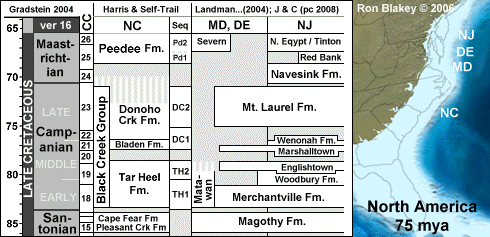 |
| Correlation chart integrated by Jim Bourdon 20081. Paleomap reproduced with the permission of Dr. Blakey 2007. |
To all but the most serious student, the lower two (western most exposures) members are of little interest. According to Carter, et al. (1988), the sandstones and mudstones of the Cape Fear, which originated in lagoonal, estuarine and marine environments, yield only pollen to the collector. The river deposits, primarily sands, sandstones and mudstones, of the Middendorf Formation contain larger plant material as well - silicified wood and fossil leaves.
Formations of the Black Creek Group (river delta) and the Peedee (open marine) are the source of most North Carolina Cretaceous fossils. Owens & Sohl (1989) extensively describe the Black Creek Group tracing its delta-shelf depositional environment and the resulting facies by location. In general, the environment of each formation is relatively similar; delta plain to the southwest, shelf to the northeast. The sands and clays of the upper delta plain tend to be largely un-fossiliferous. The facies then change to black, carbonaceous clays interbedded with white/buff micaceous sands and produce plant material. These are followed by interbeds of clay and glauconitic quartz sand, which yield plant & invertebrate material. Upper deposits become dark sands and clays with coarser sands, phosphatic and gravel layers and occasional sandstone lenses.
According to Carter, et al. (1988), the Peedee Formation of the southeastern Coastal Plain is made up of massive sands and limestones, which can be quite fossiliferous and include invertebrates, phosphatic bones & teeth and plant material. In the Wilmington, NC area, the upper Peedee is made-up of quartz sandstone and sandy limestone.
With that said, the Eocene Castle Hayne Formation often contains reworked Late Cretaceous material. In Wayne County, both Black Creek and Peedee taxa may be picked, often in great abundance, directly from the Castle Hayne limestone.
STRATIGRAPHIC PROVENANCE
Despite the abundance of Late Cretaceous material much of it lacks stratigraphic context. Creek bottoms are screened in many areas or mixed mine tailings are picked. Even when specimens are found in situ, it can be quite misleading. At one site we've collected, the roots of a fallen tree harbor a host of large Cretaceous teeth; however, additional study found that these roots were above a Castle Hayne (Eocene) exposure only 10 yards away. This Castle Hayne limestone (sandy bryozoan hash) was dominated (98%) by reworked Black Creek and Peedee vertebrates. This exposure has proven invaluable for the smaller well preserved specimens within it -- some of which have never been reported from North Carolina. None of the below imaged specimens were river screened or surface collected, their origin is either Tar Heel Fm, or from the above Castle Hayne site. Specimens lacking both a firm identification and stratigraphic context were not included. In the below list referring to a specimen as Late Cretaceous indicates it's reworked and we are uncertain of the origin. Listing a formation indicates the formation from which we have collected the material. Additional detail may be included in the comments.
FAUNA
Late Cretaceous NC marine sediments yield numerous reptile, bony fish and shark fossils. The reptile remains tend to be dominated by turtle fragments likely the result of predation by the numerous Crocodylians (particularly Deinosuchus) that co-inhabited these waters. Fish remains are similarly common, but often dominated by isolated non-descript pycnodontid-like teeth; Enchodus teeth can be regularly found.
CHONDRICHTHYAN FAUNA
Of primary relevance to this website are the sediments that produce vertebrate material, particularly sharks and rays - consequently the discussions will be limited to the Black Creek Group and Peedee Formation. Intended only to be a quick overview of the NC Cretaceous, the units that comprise the Black Creek Group will be "lumped" together for discussion purposes. The authors, unless otherwise noted, collected all listed species or discussed specimens.
The Black Creek Group
In most cases, the best vertebrate collecting in these units occurs in gravel lenses that concentrate reworked phosphatic material. Productive exposures yield large numbers of teeth and other fossils, particularly if a fine screen is employed. The relative abundance as discussed by the authors is based on the off-site processing of finer material. In addition to the chondrichthyan material featured in the below list, normal collecting results include a number of bony fish (Enchodus, Anomoeodus, Albula, Paralbula, etc.) and reptile teeth.
Peedee Formation
Neither of the authors has experience working the Peedee, but isolated encounters had occurred while working the overlying Eocene. The development of the Wayne County site provided a great opportunity to better understand this fauna. Although reworked into the Castle Hayne, many of these specimens could be mapped to Maastrichtian faunas of the Gulf Coast. (Rome Lytton has provide a Peedee Fauna from Lake Waccamaw, NC.)
| | | | |
| CLICK ON IMAGES FOR ADDITIONAL DETAILS |
| HYBODONTIFORMES |
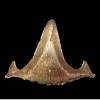 |
Meristodonoides cf novojerseyensis (CASE & CAPPETTA, 2004) — extinct family of hybodont sharks
Tooth fragments are somewhat common in Black Creek sediments, complete crowns rare, dorsal spines uncommon.
Robb (1989) lists M. montanensis CASE 1978 as present in the Black Creek sands. |
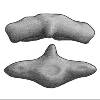 |
Lonchidion (fka Lissodus) cf babulskii CAPPETTA & CASE 1975a - extinct family
Relatively common in certain Black Creek sediments when finer material evaluated. Most specimens lack
roots and the crowns are worn (feeding or transportational). This specimen compares well with L. selachos.but is most likely L. babulskii |
| SQUATINFORMES |
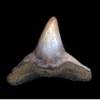 |
Squatina "hassei" LERICHE, 1929 — angel shark
Squatina teeth are a regular component of a day's Black Creek take, but roots are rarely in good condition. 'Hassei" is a bucket for Cretaceous angel shark teeth and shouldn't be deemed a definitive taxon. |
| UNDETERMINED |
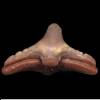 |
Undetermined
There are no reports of serrated shoulders on Cretaceous angel shark teeth so this charcteristic cannot be determined to be within the design-envelope of hassei. The uvula is significant and no nutrient groove is present. |
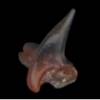 |
Undetermined
Singular example known from reworked Late Cretaceous material. Design suggests Cretorectolobus, Squatina or Onchopristis, but a proper determination is uncertain. |
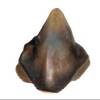 |
Undetermined — probably orectolobid
Reworking of this singular example precludes proper identification. It is reminiscent of the "Brachaelurus" specimen figured in Cappetta & Case (1975: 12) aka Chiloscyllium greeni as depicted in Welton & Farish (1993: 81). |
| ORECTOLOBIFORMES |
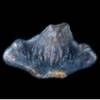 |
Cantioscyllium cf decipens WOODWARD, 1889 — nurse shark
When processing finer material from Black Creek Group, these teeth may be deemed uncommon. |
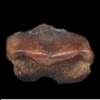 |
"Ginglymostoma" globidens (CAPPETTA & CASE, 1975) — nurse shark
An uncommon tooth in the Black Creek Group, and when found, the roots are usually "shot". |
 |
Plicatoscyllium minutum (FORIR, 1887) — Extinct nurse shark
Another uncommon tooth from the Black Creek Group, it usually has a very worn root. This design with its plicated crown includes teeth formerly referred to as Ginglymostoma minutum and lehneri. |
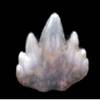
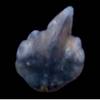 |
Undetermined nurse sharks. In addition, the reworked Wayne County site yields other nurse shark crown-designs. Few have good roots, so these are meant to illustrate examples. |
| LAMNIFORMES |
| ANACORACIDS |
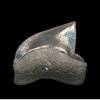 |
Squalicorax lindstromi (DAVIS, 1890) — crow shark
Abundant in Black Creek sands and Peedee Formation. The mesial edge is convex with small serrations, the distal notched to form a heel. Formerly referred to as S. "kaupi". |
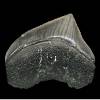 |
Squalicorax "pristodontus" (AGASSIZ, 1843) — crow shark
Somewhat common in Black Creek sands and Peedee Formation. Peedee specimens are often large and in exceptional condition; note the lack of a distal heel. |
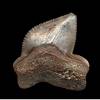 |
Squalicorax cf yangaensis (DARTEVELLE & CASIER, 1943) [fka S. "bassanii" (GEMMELLARO, 1920)] — crow shark
Distinguished by the mesial concavity on the lower mesial edge and inflated mesial serrations, teeth from this Campanian taxon are often quite common. |
| ODONTASPIDIDS |
 |
Carcharias samhammeri (CAPPETTA & CASE, 1975) — sandtiger
When present, these sandtigers are common and can be differentiated by their smooth crown in all tooth-positions. Also see: see sorting Cretaceous sand tigers. |
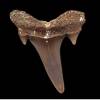 |
Eostriatolamia holmdelensis (CAPPETTA & CASE, 1975) — sandtiger
The striated crown distinguishs these teeth from C. samhammeri and the lack of a basal bulge form Odontaspis. These teeth are relatively uncommon. Also see: see sorting Cretaceous sand tigers. |
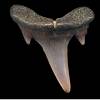 |
"Odontaspis" hardingi CAPPETTA & CASE, 1975 — sandtiger
The inflated lower labial margin helps distinguished these striated teeth from those of E. holmdelensis and the short cusplets from O. aculeatus. These teeth are uncommon to scarce in the Tar Heel Fm. Also see: see sorting Cretaceous sand tigers. |
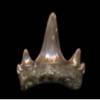 |
Odontaspis aculeatus (CAPPETTA & CASE, 1975) — sandtiger
This striated tooth-design is more reminiscent of O. ferox with long slender cusplets. These teeth are scarce and usually worn/damaged. Also see: see sorting Cretaceous sand tigers. |
| "MITSUKURINIDS" |
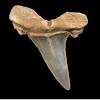 |
Scapanorhynchus texanus (ROEMER, 1849) — goblin shark
The teeth of this species are found in the Peedee and are abundant in the Tar Heel Fm. The strongly striated, awl-like anteriors are readily identifiable except when intermixed with Striatolamia in certain Castle Hayne Fm exposures. Also see: see sorting Cretaceous sand tigers. |
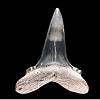 |
Anomotodon toddi CASE & CAPPETTA 1997 — goblin shark
Accompanying specimen from Black Creek lag, probably Peedee Fm. |
| "ARCHAEOLAMNIDS" |
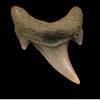 |
Archaeolamna kopingensis (DAVIS, 1890) — mackerel shark
Formerly referred to as Plicatolamna arcuata or more recently, Cretodus arcuatus, teeth from this species are generally uncommon in Tar Heel sediments and listed by Case (1979) as probably present in the Peedee. |
| "OTODONTIDS" |
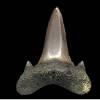 |
Cretalamna appendiculata (AGASSIZ, 1843) — mackerel shark
Common in North Carolina as in other East Coast Cretaceous locales. |
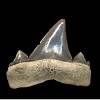 |
Cretalamna maroccana aka C. biauriculata maroccana(ARAMBOURG, 1935) — mackerel shark
Teeth of this design appear to be relatively uncommon in the Peedee and Black Creek sands. The actual genus to which they should be ascribed remains in question. |
| "SERRATOLAMNIDS" |
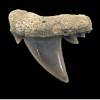 |
Serratolamna serrata (AGASSIZ, 1843) — mackerel shark
A common tooth in the Tar Heel and Peedee Formation. The assymetrical shoulders of the lateral files are quite recognizable. |
| "CRETOXYRHINIDS" |
 |
Cretoxyrhina mantelli (AGASSIZ, 1843) — extinct lamniform
Rare in the studied exposures the accomanying Bladen Co. tooth (Tar Heel Formation) was likely reworked from earlier sediments. |
| CARCHARHINIFORMES |
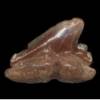 |
Palaeogaleus aff faujasi HERMAN, 1977 — extinct houndshark
A single specimen has been recovered from reworked Late Cretaceous (Campanian or Mssatrichtian) sediments which compares better with Herman's taxon than those from the Late Cretaceous of Texas. |
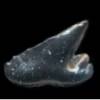 |
Galeorhinus aff girardoti HERMAN, 1977 — extinct houndshark
A couple damaged Galeorhinus teeth have been recovered from reworked Late Cretaceous (Campanian or Masstrichtian) sediments. |
| SCLERORHYNCHIFORMES |
| "SCLERORHYNCHIDS" |
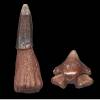 |
Ischyrhiza mira LEIDY 1856 — extinct sawfish
Rostral spines and oral teeth common in Black Creek sands. (Oral teeth require close examination of sand/gravel offsite.) |
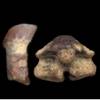 |
"Ischyrhiza cf avonicola" ESTES 1964 — extinct sawfish
Scarce in Late Cretaceous sediments of NC. The oral tooth design may include teeth referred to as Ptychotrygon sp A below. Also see rostral spine discussion. |
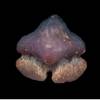 |
undetermined sclerorhynchid — extinct sawfish
Scarce in Late Cretaceous sediments and represented by oral teeth only. Lacking rostral spines, it has been deemed imprudent to ascribe these teeth to a particular taxon at this time. |
| "PTYCHOTRYGONIDS" |
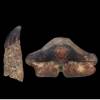 |
Ptychotrygon vermiculata CAPPETTA 1975 — extinct sawfish
A common to abundant tooth-design in the Tar Heel Fm when finer material is studied. P. vermiculata appears to be a chronospecies of P. triangularis (REUSS 1844). Rostral spines are much less common, see discussion. |
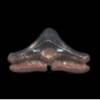 |
?Ptychotrygon cuspidata CAPPETTA & CASE, 1975 — extinct sawfish
Scarce tooth-design when processing Late Cretaceous matrix from NC. |
 |
"Ptychotrygon sp A" — extinct sawfish
Somewhat uncommon tooth-design when processing Late Cretaceous matrix from NC. These teeth may be variations of the design ascribed to "Ischyrhiza cf avonicola" above. |
| RAJIFORMES |
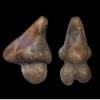 |
"Raja" farashi Case & Cappetta 1997 — extinct rajiform
This tooth-design has been reported from the Maastrichtian of Texas, Arkansas and Maryland and deemed a skate by the describer. In this reworked Wayne Co. specimen the roots are severely eroded (see Welton & Farish 1993:137). |
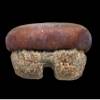 |
"Pseudohypolophus" ellipsis CASE et al. 2001 — extinct ?guitarfish.
Common to abundant in Campanian Black Creek sands, but roots often gone or significantly eroded. |
| incertae sedis |
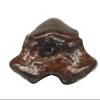 |
Ewingia problematica CASE & CAPPETTA 1997 — extinct batoid
Referred to as a tooth by the describers, this fossil has been reported from the Maastrichtian of Texas & Maryland and recovered from reworked Late Cretaceous of Wayne Co., NC. |
| MYLIOBATIFORMES |
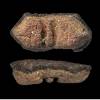 |
Brachyrhizodus wichitaensis
ROMER, 1942 — extinct ray genus
Specimens somewhat common in most Tar Heel (Campanian) sediments, but usually quite worn. There is no reported evidence of these teeth from the Peedee Fm. |
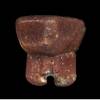 |
Rhombodus levis
CAPPETTA & CASE 1975 — extinct ray genus
Worn teeth from this tooth-design are common in Tar Heel Fm (Campanian) sands. |
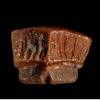 |
Rhombodus binkhorsti DAMES 1881
— extinct ray genus
Reported by Case (1979) as present in the Peedee Formation (Maastrichtian). The accompanying image was reworked into the Castle Hayne (probably from the Peedee Fm). |
 |
Texabatis corrugata CASE & CAPPETTA 1997 — extinct stingray
Although worn, the crown design compares well with described material; from reworked Late Cretaceous (Campanian but probably Maastrichtian) sediments -- uncommon to scarce. |
AKNOWLEDGEMENTS
We would like to thank others who have assisted with this project: Richard Chandler, Gilles Cuny, Pascal Deynat, Bill Harris (stratigraphy), Bill Heim, Fabrice Moreau, Al Robb, Mikael Siverson, Ed Swiatovy, Charlie Underwood and Pat Young. Howie Cohn contributed significant time and labor as we quarried the Wayne County site and Earl Manning provided invaluable assistance with identifications, opinions and mapping this fauna with that of the Gulf Coast. David Schwimmer assisted with reptile determinations.
FOOTNOTES
| 1. |
The revised chart was developed working with Earl Manning on a collateral project. Ralph Johnson and Wayne Callahan assisted with the NJ , DE & MD portions of the chart and Jean Self-Trail in refining the NC unit positioning. |
| 2. |
When first included in this webpage, reptile teeth were identified differently. Figure d was captioned Deinosuchus priscus, however: Leidy (1856: 255) described Pliogonodon priscus based on specimens from the Emmons' collection but never figured the specimens. Emmons (1858: 219-22) described Polyptychodon rugosus and figured two specimens (figs. 38, 39, from Elizabethtown, NC). Schwimmer (pers. com. 2010) noted that the lack of figures and formal description in Leidy's note deem "priscus" a nomen nudem (by ICZN rules) and this specimen should be referred to as cf. Deinosuchus rugosus. In addition, two specimens b,g were attributed to Leidyosuchus canadensis, however, David also noted, "not sure any valid occurrences of Leidyosuchus are known in the eastern USA (we do have Borealosuchus, which Brochu (1997a) separated from Leidyosuchus)." Schwimmer went on to note, " I'd also suggest not identifying Cimoliosaurus magnus (Fig, a,f) by the teeth, since these are not diagnostic characters of the genus. These are clearly plesiosaur teeth, but there is no firm generic (let alone specific) identification possible from them. It is traditional to classify eastern plesiosaurs as Cimoliosaurus because it is known from better material in New Jersey; but, this a poor and obsolete practice ... call these teeth "Plesiosauridae, gen. & sp. indet.". |
REFERENCES
Brochu, C. A., 1997a. A review of Leidyosuchus (Crocodyliformes, Eusuchia)from the Cretaceous through Eocene of North America. Journal of Vertebrate Paleontology 17:679-97.
Cappetta, H. & Case, G., 1975. Contribution à l'étude des sélaciens du groupe Monmouth (Campanien - Maestrichtian) du New Jersey. Palaeontographica Abteilung A, 151:1-46.
Carter, J., Gallagher, W. Enos Valone, R., and Rossbach, T., 1988. Fossil Collecting in North Carolina, North Carolina Geological Survey. 89pp.
Case, G., 1979. Cretaceous Selachians from the Peedee Formation (Late Maestrichtian) of Duplin County, North Carolina, Brimleyana, Vol 2, pp 77-89.
Case, G. and Cappetta, H.. 1997. A new selachian fauna from the late Maastrichtian of Texas. Münchener Geowissenschaften Abhandungen 34:131-189.
Case, G., and H. Cappetta, 2004. Additions to the elasmobranch fauna from the Upper Cretaceous of New Jersey (Middle Maastrichtian, Navesink Formation). Palaeovertebrata 33.
Emmons, E., 1858. Agriculture of the eastern counties together with the descriptions of the fossils of the marl beds. North Carolina Geological Survey. 314 pp.
Gradstein, F., Ogg, J. & Smith, A., 2004, A Geological Time Scale 2004. Cambridge University Press. 589pp.
Harris, W. and Self-Trail, J., 2006. Late Cretaceous base level lowering in Campanian and Maastrichtian depositional sequences, Kure Beach, North Carolina. Stratigraphy, vol. 3.3, pp. 195-216.
Hartstein, E., Decina, L. and Keil, R., 1999. A Late Cretaceous (Severn Formation) Vertebrate Assemblage from Bowie, Maryland. The Mosasaur, Vol 6, Delaware Valley Paleontological Society. pp 17-23.
Herman, J., 1977. Les Sélaciens des terrains néocrétacés & paléocènes de Belgique & des contrées limitrophes Eléments d'une biostratigraphie intercontinentale. Mem. Expl, Cartes Géo. & Min. de la Belg, Mém, no. 15, 450 pp, 25 figs, 21 pls.
Kellum, L., 1926. Paleontology and stratigraphy of the Castle Hayne and Trent Marls of North Carolina. USGS Professional Paper, 143:56pp.
Landman, N., Johnson, R. and Edwards, L., 2004. Cephalopods from the Cretaceous/Tertiary Boundary Interval on the Atlantic Coastal Plain, with a Description of the Highest Ammonite Zones in North America. Part 1. Maryland and North Carolina. Amer. Mus. Novitates, No 3454, 64pp.
Lauginiger, E., 1986. An Upper Cretaceous vertebrate assemblage from Big Brook, New Jersey. The Mosasaur vol 3, Delaware Valley Paleontological Society, pp 53-61.
Leidy, J. 1856. Notices of Remains of Extinct Vertebrated Animals discoverd by Professor E. Emmons. Proceedings Academy of Natural Sciences, Philadelphia, vol. 8: 255-57.
Leidy, J., 1865. Cretaceous Reptiles of the United States. Smithsonian Contributions to Knowledge. 135 pp.
Manning, E., 2006. Late Campanian vertebrate fauna of the Frankstown site, Prentiss County, Mississippi; systematics, paleoecology, taphonomy, sequence stratigraphy. Unpub. PhD dissertation, Tulane Univ., New Orleans, xvii+419 p., 16 pls.
Owens, J. and Sohl, N., 1989. Campanian and Maastrichtian Depositional Systems of the Black Creek Group of the Carolinas, North Carolina Geological Survey. 23pp.
Robb, A., 1989. The Upper Cretaceous (Campanian, Black Creek Formation) Fossil Fish Fauna of Phoebus Landing, Bladen County, North Carolina, The Mosasaur, vol 4, Delaware Valley Paleontological Society, pp 75-92.
Schwimmer, D., 1986. Late Cretaceous fossils from the Blufftown Formation (Campanian) in western Georgia. The Mosasaur. Delaware Valley Paleontological Society. pp 109-119.
Schwimmer, D., 2002. King of the Crocodylians, the paleobiology of Deinosuchus. Indiana Univ. Press. 220pp.
Sohl, N. and Owens, J., 1991. Cretaceous stratigraphy of the Carolina coastal plain, IN Horton, J., Jr., & Zullo, V., eds., The geology of the Carolinas: Carolina Geological Society, 50th Anniversary Volume, p. 191-220.
Timmerman, J. and Chandler, R., 1995. Cretaceous and Paleogene Fossils of North Carolina: A Field Guide. North Carolina Fossil Club, Durham. 70pp.
Weems, R., Self-Trail, J. & Edwards, L., 2004, Supergroup Stratigraphy of the Atlantic and Gulf Coastal Plains (Middle? Jurassic through Holocene, Eastern North America). Southeastern Geology 4:2, USGS pp191-216.
Although NC Cretaceous exposures are widespread and productive, there are few "walk on sites" readily
accessible to, or collectable by, the casual visitor. Those seriously interested in collecting these exposures
would be advised to do so with an established Paleo-club. The
North Carolina Fossil Club
regularly visits sites throughout the state.
If you can provide feedback or help us with this effort, contact:
Jim Bourdon or
Kim Greene
|